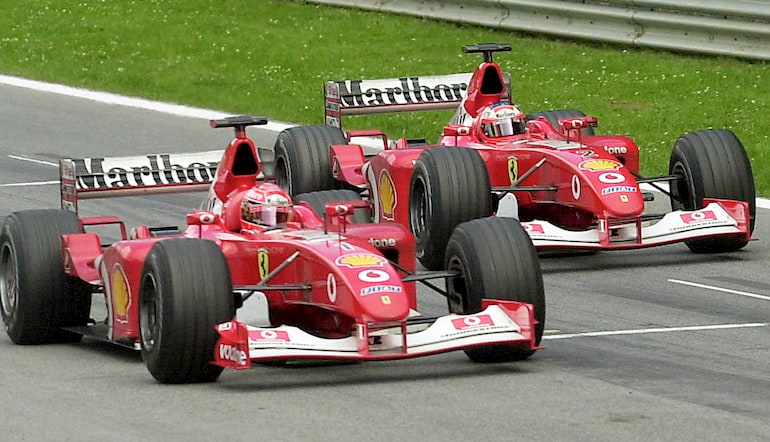Formula One teams are much more than the drivers. Thousands work on developing the car, transportation and in the pitlane.
How much of success is down to driver skill is a timeless debate of the sport. Downplaying drivers’ impact is a mistake, however.
Selecting and managing Formula One drivers is a key part of the sport. Having the best driver of all-time is worth more than an also-ran from Formula Two.
Keeping your two drivers happy is as important as having a car that can complete a race – a conflict in the team can become detrimental.
Teams are not just picking from drivers who want to race in Formula One. They aren’t just trying to negotiate contracts and throwing them in a car.
It is a working relationship, and there’s a tightrope to walk with two drivers on each team, a tightrope with team-harming consequences on either side.
Ferrari made Michael Schumacher their undisputed number one with Rubens Barrichello his sidekick.
Brawn leant a similar way with Jenson Button and Barrichello. McLaren used Button and Hamilton, two world champions, as a relatively level pair.
Lead Driver Makes Life Easier
The team structure is more straightforward with a number one. Their car will be prioritised, and race strategy will be focused on them getting maximum points, often sacrificing their teammate.
The most famous example, of course, came when Schumacher passed Barrichello at the end of the 2002 Austrian Grand Prix.

A pre-established order in the team will rarely be popular with the neutrals. The secondary driver seems hard done by, as they effectively rule out any chance of personal success.
Ferrari’s move in 2002 was a scandal, a dark day for the sport. That is an exception to how a lead driver system works, but it shows the uneasy consequences of such decision-making and the awkward position it can put the second driver in.
Teams More Vulnerable
Operating with a lead driver makes teams more vulnerable. Mercedes, for instance, would be lost without Hamilton.
If, and it’s an almighty if at this juncture, Hamilton departs for another team or posts a shock retirement on Instagram, the Silver Arrows would have a Hamilton-shaped hole in their team.
Is Valtteri Bottas the man to step into that void? Or would they be left searching for an experienced race winner?
Using the example of McLaren with Button and Hamilton: They were covered if one left, they had a world champion ready to become the number one if they couldn’t recruit another seasoned campaigner to accompany them to the most popular tracks in F1.
Red Bull favour their young driver programme, plucking drivers from Toro Rosso. Alex Albon and Pierre Gasly both shared a garage with Max Verstappen in 2019.
Waving goodbye to Verstappen (imagine him in a Mercedes with Hamilton) would leave them in a driver predicament.
Promotes Competitiveness
The great Formula One internal rivalries have provided some of the sport’s greatest racing.
It’s not just from an entertainment perspective that it’s a winning formula either – Hamilton and Nico Rosberg pushed each other on, and Ferrari hope for the same with Sebastian Vettel and Charles Leclerc in 2020.
It can make F1 betting online riskier. Vettel and Leclerc showed us why at the 2019 Brazilian Grand Prix, recklessly colliding as they pushed each other for position.
The added fire of internal team rivalry can cause errors of judgement.
Discontent
Daniel Ricciardo left Red Bull because he felt the team favoured Max Verstappen. Vettel might make a similar decision if 2020 sees Ferrari lean towards Leclerc.
Certain personalities are not suited to being second fiddle, and those fractures in a team can lead to not just uncomfortable meetings, but lost points on the track as the red mist descends.
An unhappy driver is never ideal. Maintaining the contentment of two fiercely competitive racers isn’t a simple task, and any team orders that can be perceived to favour one over the other will likely provoke problems.
Some will be more amiable to settling for second places and relinquishing their own chance at a world title. Barrichello took pride in enabling the titles for Schumacher.
Bottas, though, has done what’s best for the team through gritted teeth at times. It isn’t a role Ricciardo or Vettel fit in to.
Situation Dictates
Picking a lead driver or opting for a pairing that will push each other, with team orders seldom heard, depends on the situation. Personalities, of the driver and of team management, will dictate the suitability of each approach.
While fans will want to see the fiercest competitors, the quickest drivers, in identical cars racing wheel-to-wheel, that is rarely a situation that works out well for teams as they pursue Constructors’ Championships.
Ferrari’s Vettel and Leclerc situation might not have worked out perfectly, but the balance of youth and experience is a good one.
Putting all their eggs in the Leclerc basket last season could have backfired horribly. Ignoring his pace and sticking with Vettel as number one would have been counter intuitive.
For Mercedes at the moment, it’s a different circumstance altogether. Hamilton would be the undisputed number one with practically any teammate.
Bottas might not always be happy about the team’s decisions, but he isn’t as likely to defy team instructions as others on the grid.
He’s a team player, an ideal second driver to pick up points, the odd race win, and assist Hamilton in his Schumacher pursuit.
There’s no clear-cut answer to whether a lead driver or an equal pairing is best. Clarity is the most important aspect of driver management – either system can work effectively if communication is clear between the team and the drivers.
*Credit for the main photo belongs to Darron Cummings / AP Photo*


